Guitar scales in TAB, notation and fretboard pattern / diagram form. Use the scales on this page for improvisation, songwriting and building up finger speed / dexterity.
For each scale you'll find:
- Information about the scale and its potential uses
- TAB for playing the scale in open position with a tonic note of C
- A movable scale pattern for playing the scale with any tonic note
- TAB for playing the scale in 2 octaves with a tonic note of C
- TAB for playing the scale in 2 octaves with a tonic note of G
- Links to additional patterns and TABs on Guitar Command
We want this page to be the best online guitar scales resource available. If you have any comments or suggestions let us know in the comments. Feel free to bookmark this page in your browser for future reference.
Page Index: Use The Links Below To Jump Straight To The Guitar Scales You Need
- Common Guitar Scales
- Pentatonic Minor Scale
- Pentatonic Major Scale
- Blues Scale
- Major Scale (Ionian Modal Scale)
- Natural Minor Scale (Aeolian Modal Scale)
- Dorian Modal Scale
- Mixolydian Modal Scale
- Less Common & Exotic Guitar Scales
- Phrygian Modal Scale
- Lydian Modal Scale
- Locrian Modal Scale
- Harmonic Minor Scale
- Phrygian Dominant Scale
- Jazz Minor Scale
- Double Harmonic Scale
- Whole Tone Scale
- Altered Scale
- Diminished Scale
- Lydian Augmented Scale
- Further Information On Guitar Scales
Other Links
- Play bass? Visit this page: Bass Scales
- How to read TAB: How To Read TAB
- How to read scale patterns: Guitar Scale Patterns
Check Out Our Book!
If you want this information at your fingertips, you can download our printable Guitar Scales Chart Book (follow the link for info on this site). It's also available in print from Amazon (follow the link to see the book at your country's Amazon).
You can practice improvising with scales using our specially-produced backing tracks. Follow these links for info & sample tracks: Guitar Scales Backing Tracks and Guitar Modes Backing Tracks.
Introduction to Guitar Scales
We want this page to be the best guitar scales reference on the internet. If you have any questions then please feel free to ask in the comments section; we'd be happy to help! We also welcome any comments / suggestions you may have on how we can make this page even better!
The first section of this page contains guitar scales commonly used by lead guitarists, including the pentatonic, blues, major and minor scales.
The second part features guitar scales that are less commonly used. Experiment with these to introduce interesting and original sounds to your solos.
Movable Guitar Scale Diagrams
All of the scales on this page are presented in fret diagram form. These show 'shapes' that can be moved up and down the fretboard in order to play the scale in any key.
The tonic notes of each scale (i.e. the 'C' notes in a C major scale, or the 'G' notes in a G pentatonic minor scale) are represented by green circles.
Additional patterns for many of the scales can be found by following the links located throughout the page.
- You can find out how to use scale patterns on this page: Guitar Scale Patterns
Common Guitar Scales
In this section, you'll find a selection of the most commonly-used guitar scales.
***
Pentatonic Minor Scale
The pentatonic minor scale is probably the most widely-used guitar scale of all. Virtually every guitarist – of every musical style – will have used it in their solos at some point.
The pentatonic scale should be one of the first guitar scales a beginner guitarist learns.
- Want to play pentatonic scales all over the neck? You'll find multiple fretboard diagrams and tabs for playing pentatonic scales on this page: Pentatonic Scale On Guitar: The Ultimate Guide
1 Octave C Pentatonic Minor Guitar Scale TAB
Pentatonic Minor Scale Pattern
Use the movable pattern above to play pentatonic minor scales with any tonic note. Examples are given below. Click on the diagram to see more fretboard patterns for this scale.
2 Octave C Pentatonic Minor TAB
2 Octave G Pentatonic Minor TAB
Back to Page Index
Pentatonic Major Scale
The major pentatonic scale produces a clear, melodic sound – ideal for soloing over major chord sequences. This scale is often used in country and rock music.
- More information on pentatonic major scales can be found on this page: Pentatonic Major Scale.
1 Octave C Pentatonic Major Guitar Scale TAB

Pentatonic Major Scale Pattern
Use the pattern above to play pentatonic major guitar scales with any tonic note. Examples are shown below. Click on the diagram or on the TABs to see more fretboard patterns for this scale.
2 Octave C Pentatonic Major TAB
2 Octave G Pentatonic Major TAB
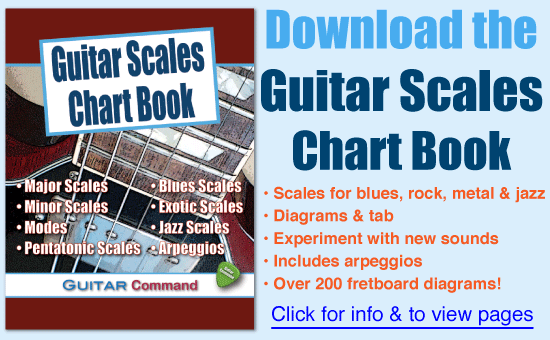
Back to Page Index
Blues Scale
The blues scale is essentially the same as a pentatonic minor scale, but with the addition of one extra note – the flattened, or diminished, fifth ... otherwise known as the 'blues note'. It's this note that gives the scale its 'bluesy' sound.
You'll hear the blues scale being used not just in blues music, but also in many other styles, including rock, metal and jazz.
- Play blues in every fretboard position! You'll find multiple fret diagrams and further information on the blues scale here: Blues Scale Guitar.
1 Octave C Blues Scale

Blues Scale Pattern
Use the movable pattern above to play blues guitar scales with any tonic note. Examples are given below. Click on the diagram or on the TABs to see more fretboard patterns for this scale.
2 Octave C Blues Scale TAB
2 Octave G Blues Scale TAB
- Back to Page Index
- Play the blues scale in A
- Go to main blues scale page
Major / Ionian Guitar Scales
The major scale produces a clear and simple sound. If you're thinking in terms of modes, the major scale can also be called the Ionian modal scale; it's exactly the same scale. Think of it as learning two scales in one!
It may have a simple sound when played on its own, but the major scale is the starting point for virtually every other scale – and for western music harmony in general. You'll need to know the major scale intimately if you want to study music theory and modal scales!
Visit the following pages on Guitar Command for more major scale info:
- Learn to play major scales all over the neck here: Major Scale Guitar
- C Major Scale Page with TAB, Notation & Info
- D Major Scale Page with TAB, Notation & Info
- E Major Scale Page with TAB, Notation & Info
- F Major Scale Page with TAB, Notation & Info
- G Major Scale Page with TAB, Notation & Info
- A Major Scale Page with TAB, Notation & Info
- B Major Scale Page with TAB, Notation & Info
1 Octave C Major Guitar Scale TAB

Major Scale Pattern
The scale diagram below shows one way of playing a major scale. You can see more major scale patterns here: Major Scale Guitar
The pattern above can be used to play major scales with any tonic note. The TABs below show it being used to play C and G major scales.
2 Octave C Major Guitar Scale TAB
2 Octave G Major Guitar Scale TAB
Back to Page Index
Natural Minor / Aeolian Guitar Scales
Natural minor scales and Aeolian scales are the same guitar scales but with different names. Use them to solo over minor chord sequences.
- For more diagrams and information visit this page: Natural Minor Scale.
Open Position 1 Octave C Natural Minor Scale TAB

Natural Minor Scale Pattern
The above pattern can be used to play natural minor scales with any tonic note. The TABs below show it being used to play C and G natural minor scales. Click on the scale diagram or TABs to see more information on this scale.
2 Octave C Natural Minor Scale TAB
2 Octave G Natural Minor Scale TAB
Back to Page Index
Dorian Modal Scale
The Dorian modal scale is popular in jazz, often being used to solo over minor seventh chords. It is also used in many other styles of music, including folk and modal jazz.
The Dorian scale is built from the second degree of a major scale.
- Find out how to play this beautiful-sounding scale all over the guitar neck: Dorian Scale Guitar.
- Learn more about modes here: Guitar Modes.
- For more information about soloing with Dorian scales, see: Improvisation With The Dorian Scale.
Open Position 1 Octave C Dorian Scale TAB

Dorian Scale Pattern
The above pattern can be used to play Dorian scales with any tonic note. The TABs below show it being used to play C and G Dorian scales.
2 Octave C Dorian Scale TAB
2 Octave G Dorian Scale TAB
Back to Page Index
Mixolydian Modal Scale
The Mixolydian scale is often used to improvise over dominant seventh chords. It's also used in traditional folk melodies. You can find out more about improvising with Mixolydian scales here: Improvisation With Mixolydian Scale.
- For more ways to play a Mixolydian scale, visit this page: Mixolydian Scale Guitar.
Open Position 1 Octave C Mixolydian Scale TAB

Mixolydian Scale Pattern
The above pattern can be used to play mixolydian guitar scales with any tonic note. The TABs below show it being used to play C and G mixolydian scales.
2 Octave C Mixolydian Scale TAB
2 Octave G Mixolydian Scale TAB
Back to Page Index
Less Common & Exotic Guitar Scales
This section contains scales that aren't as widely-used as those in the previous section. Here you'll find scales that will give your solos an original sound that will really make you stand out from the crowd!
- You can see more exotic scales here: Exotic Guitar Scales.
- Download our Guitar Scale Chart Book to have access to every guitar scale you'll ever be likely to need – at your fingertips! See sample pages here: Guitar Scale Chart Book.
***
Phrygian Modal Scale
The Phrygian scale is the third mode of a major scale. Its minor third gives it a minor tonality, and the semitone interval between its first two notes gives it a Spanish / Arabic sound.
As well as being used in Spanish and Flamenco music, the Phrygian scale is also used in rock and metal.
- For more information visit: Phrygian Scale Guitar.
Open Position 1 Octave C Phrygian Scale TAB

Phrygian Scale Pattern
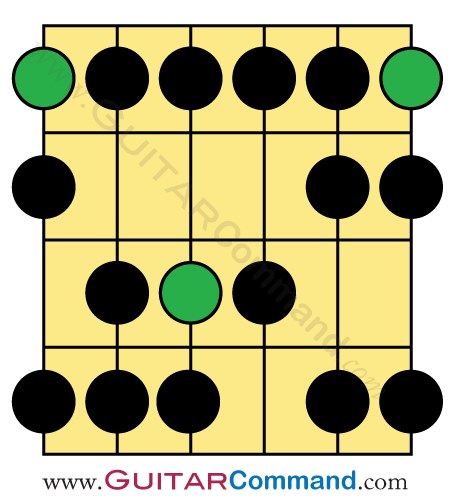 Use the movable pattern above to play this scale with any tonic note. Examples are given below. Click on the diagram or on the TABs to see more fretboard patterns.
Use the movable pattern above to play this scale with any tonic note. Examples are given below. Click on the diagram or on the TABs to see more fretboard patterns.
2 Octave C Phrygian Scale TAB
2 Octave G Phrygian Scale TAB
Back to Page Index
Lydian Modal Scale
The sharpened fourth in a Lydian modal scale produces a unique sound mainly used by jazz and fusion guitarists.
Open Position 1 Octave C Lydian Scale TAB

Lydian Scale Pattern
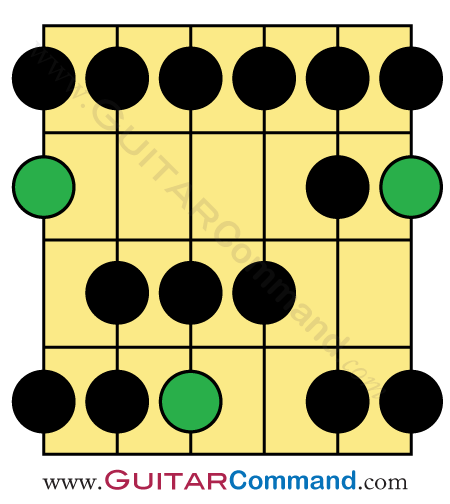
Use the movable pattern above to play this scale with any tonic note. Examples are given below.
2 Octave C Lydian Scale TAB

2 Octave G Lydian Scale TAB

Back to Page Index
Locrian Scale For Guitar
Locrian modal scales produce a strange, somewhat ambiguous sound. They are formed from the seventh degree of a major scale. They are one of the few guitar scales that fit over minor seventh flat 5 chords (m7b5).
Open Position 1 Octave C Locrian Scale TAB

Locrian Scale Pattern
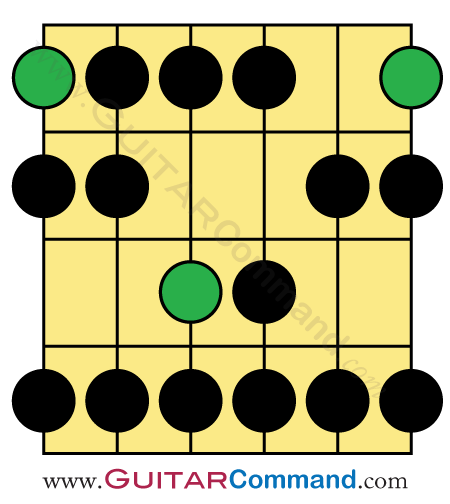
Use the movable pattern above to play this scale with any tonic note. Examples are given below.
2 Octave C Locrian Scale TAB

2 Octave G Locrian Scale TAB

Back to Page Index
Harmonic Minor Scale
The harmonic minor scale is used to harmonize minor melodies in classical music – hence the name. Today it is often utilized by jazz and metal players, and also in flamenco music. Try using it over a minor chord sequence – you might find yourself coming up with some Bach or Vivaldi-esque lines!
- For more information visit: Harmonic Minor Scale Guitar.
Open Position 1 Octave C Harmonic Minor Scale TAB

Harmonic Minor Scale Pattern
Use the movable pattern above to play this scale with any tonic note. Examples are given below. Click on the diagram or on the TABs to see more fretboard patterns.
2 Octave C Harmonic Minor Scale TAB
2 Octave G Harmonic Minor Scale TAB
Back to Page Index
Phrygian Dominant Scale
The phrygian dominant scale has several other names – it also goes by the name of the 'Freygish' or 'Spanish Gypsy' scale. It is a very characterful scale, suggestive of Spanish and Middle Eastern music.
The Phrygian dominant is one of several guitar scales favored by metal guitarists wanting to inject an exotic sound into their solos.
This scale can also be thought of as the fifth mode of a harmonic minor scale.
- For further information, visit: Phrygian Dominant Scale.
Open Position 1 Octave C Phrygian Dominant Scale TAB

Phrygian Dominant Scale Pattern
Use the movable pattern above to play this scale with any tonic note. Examples are given below. Click on the diagram or on the TABs to see more fretboard patterns.
2 Octave C Phrygian Dominant Scale TAB
2 Octave G Phrygian Dominant Scale TAB
Back to Page Index
Jazz Minor Scale
The jazz minor scale is sometimes known in rock and jazz as the melodic minor, or the jazz melodic minor (it's the same as the ascending form of the melodic minor scale in classical music theory). It produces interesting, jazz-like sounds over minor chords.
- For more information on this scale, visit: Jazz Minor Scale.
Open Position 1 Octave C Jazz Minor Scale TAB

Jazz Minor Scale Pattern
Use the movable pattern above to play this scale with any tonic note. Examples are given below. Click on the diagram or on the TABs to see more fretboard patterns.
2 Octave C Jazz Minor Scale TAB
2 Octave G Jazz Minor Scale TAB
Back to Page Index
Double Harmonic Guitar Scales
The double harmonic guitar scale is one of several scales known as the Arabic scale. (You can see more on this page: Arabic Scales.) Use it to introduce an exotic, 'Middle Eastern' sound into your solos.
Open Position 1 Octave C Double Harmonic Scale TAB

Double Harmonic Scale Pattern
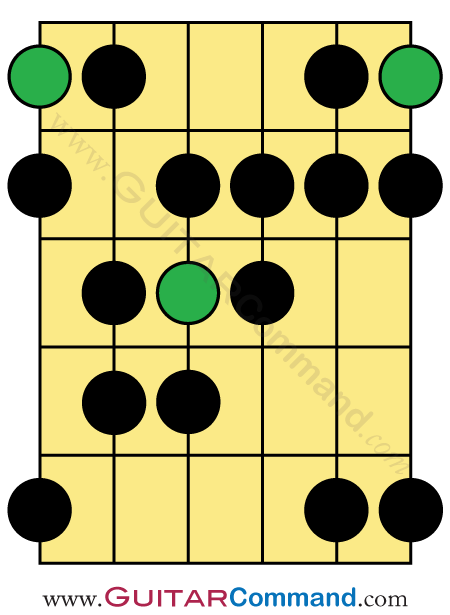
Use the movable pattern above to play this scale with any tonic note. Examples are given below.
2 Octave C Double Harmonic Scale TAB

2 Octave G Double Harmonic Scale TAB

Back to Page Index
Whole Tone Scale
The whole tone scale produces an unsettling, 'ambiguous' sound. It's used by jazz guitarists to improvise over dominant chords as it produces jazzy-sounding dissonances / tensions.
Every note in a whole tone scale is the same distance from its neighbor (as the name suggests, the interval between each note is a whole tone, or whole step). For this reason any of the notes in the scale pattern below could potentially be a tonic note (because, for example, a C whole tone scale contains the same notes as a D whole tone scale).
- You can find more information on this page: Whole Tone Scale Guitar.
Open Position 1 Octave C Whole Tone Scale TAB

Whole Tone Scale Pattern
Use the movable pattern above to play this scale with any tonic note. Examples are given below. Click on the diagram or on the TABs to see more fretboard patterns.
2 Octave C Whole Tone Scale TAB
2 Octave G Whole Tone Scale TAB
Back to Page Index
Altered Scale
The altered scale uses the same notes as a jazz minor scale, but starts and ends on the seventh degree of that scale.
When an altered scale is played over a dominant chord with the same root note (i.e. when a G altered scale is played over a G dominant chord) it produces every possible altered note. For this reason the altered scale is often used by jazz musicians, who exploit the 'tensions' produced by the altered notes.
- You'll find more information on this scale here: altered scale.
Open Position 1 Octave C Altered Scale TAB

Altered Scale Pattern
Use the movable pattern above to play this scale with any tonic note. Examples are given below. Click on the diagram or on the TABs to see more fretboard patterns.
2 Octave C Altered Scale TAB
2 Octave G Altered Scale TAB
Back to Page Index
Diminished Guitar Scales
The intervals between the notes of a diminished scale alternate between whole and half steps. Diminished scales are 'octatonic', which means that they contain eight notes per octave (by contrast 'normal' scales such as the major and harmonic minor are 'heptatonic'; i.e. they contain 7 notes per octave).
Diminished scales can be used to solo over diminished chords. They can also be used to solo over dominant chords, by playing the scale with the root a half-step higher than the chord. The resulting tensions create jazzy sounding lines.
- See this page: Diminished Scale Guitar for more information.
Open Position 1 Octave C Diminished Scale TAB

Diminished Scale Pattern
Use the movable pattern above to play this scale with any tonic note. Examples are given below. Click on the diagram or on the TABs to see more fretboard patterns.
2 Octave C Diminished Scale TAB
2 Octave G Diminished Scale TAB
Back to Page Index
Lydian Augmented
The Lydian augmented scale is a Lydian scale with a raised fifth. It can be used to create interesting lines over augmented chords. The scale can also be used to create tension-filled lines over other altered chords by using the scale with its root a major third above the root of the chord.
Open Position 1 Octave C Lydian Augmented Scale TAB

Lydian Augmented Scale Pattern
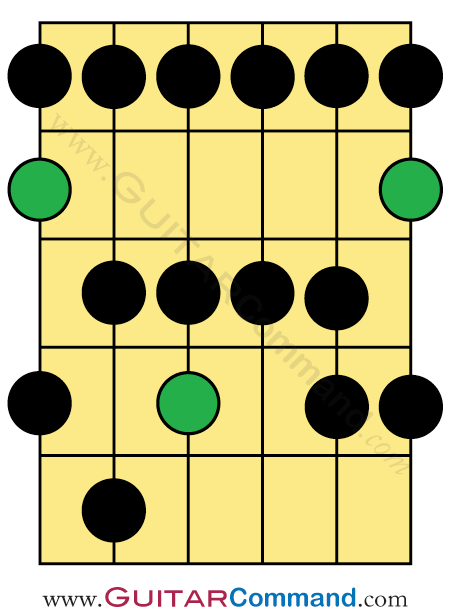
2 Octave C Lydian Augmented Scale TAB

2 Octave G Lydian Augmented Scale TAB

Back to Page Index
Further Information On Guitar Scales
Fingering
There is often more than one way to play these scale shapes. Experiment to find the fingering that works best for you.
Guitar Scales Diagrams
Guitarists are lucky because just one scale shape can be used to play that scale in any key. All we need to do is to move the shape to the right fret. This is why guitar scale diagrams are so useful.
Scale diagrams show us the 'shapes' that the scales make on the fretboard. If the shape of a scale is learned for a particular scale, then that same shape can be played elsewhere on the fretboard to produce the same type of scale in a different key.
For example, if you know where your fingers should go (i.e. the scale 'shape' as shown on a scale diagram) to play a G major scale starting on the third fret of the sixth string, you could play a C major scale at the eighth fret using the same shape. Just move your hand up (closer to you) five frets.
Why More Than One Shape For Each Scale?
It is often beneficial to learn more than one way of playing a particular scale. This will enable you to play solos without having to frequently change position on the neck.
For example, if you are playing an E minor scale at the seventh fret, and you then wanted to play a C major scale, you would simply play the major scale shape that starts at the eighth fret.
If you only knew a major scale shape that started on the fifth string, you would have to move to the third (or fifteenth) fret to play a C major scale.
Most of the scales on this page have links that you can follow to see more patterns.
Conclusion & More Scales For Guitar
We hope that you have found this collection of guitar scales useful. Explore the links for further information about each scale and build up your scale vocabulary.
You don't have to learn every scale in every position. Simply use the scales that you like and build up your scale knowledge as and when you need it.
For more guitar scale information, check out the following pages:
- Metal Guitar Scales
- Jazz Guitar Scales
- Spanish Guitar Scales
- Arabic Guitar Scales
- Japanese Scales
- Exotic Scales
- Gypsy Scale
- Diminished Scale
- Bebop Scale
- Enigmatic Scale
Other Pages to Check Out
- Download our printable Guitar Scales Book
- ... or get a copy from Amazon (link will take you to your local Amazon site)
- Practice improvising with scales: Guitar Scales Backing Tracks
- Practice improvising with modes: Guitar Modes Backing Tracks
We want Guitar Command to be the best guitar scales reference site on the web. Please bookmark this page and tell your friends / link to this page if you found it useful. We'd also really like to hear what you think in the comments below.
Enjoy the guitar scales on this page and happy jamming!

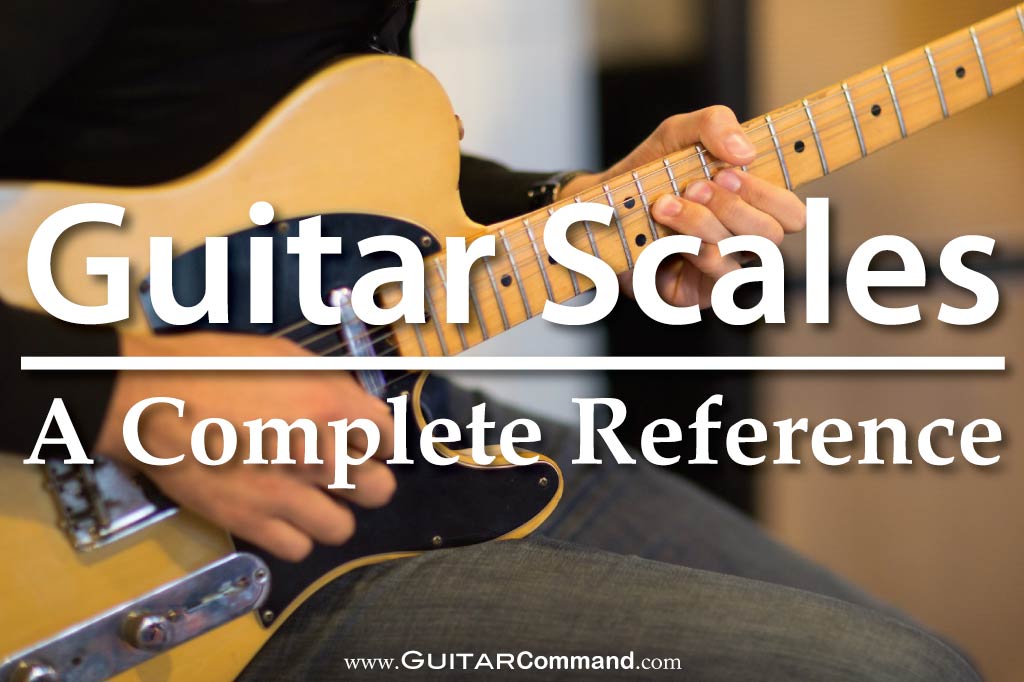
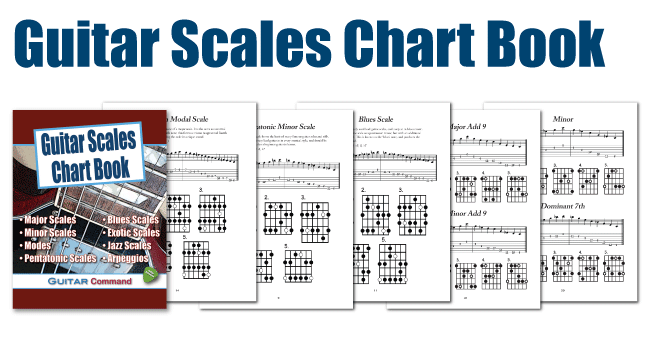

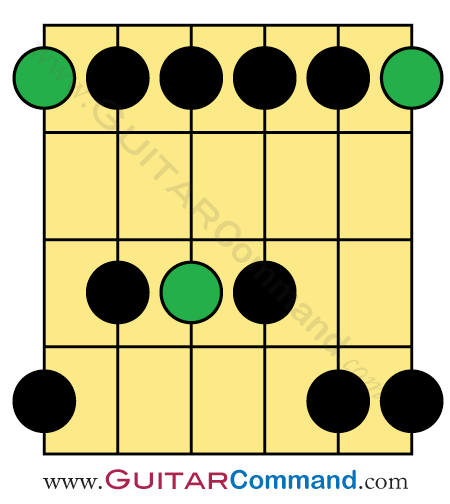


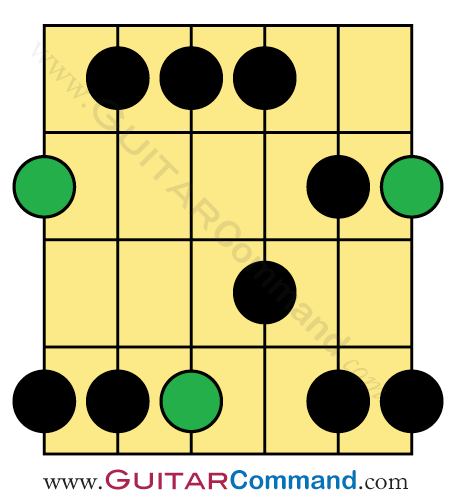





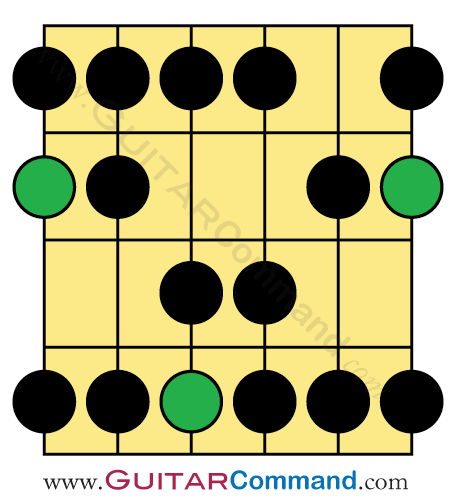


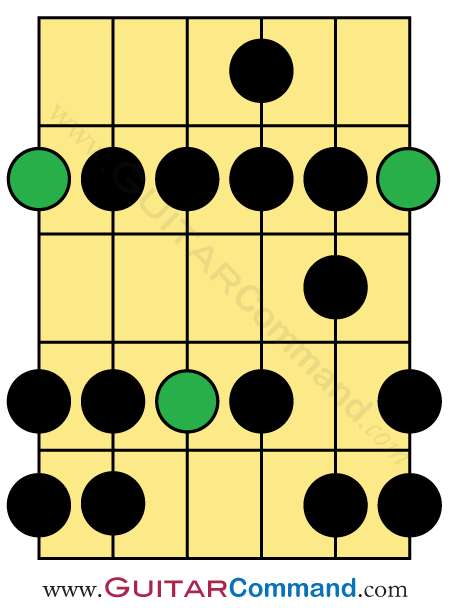


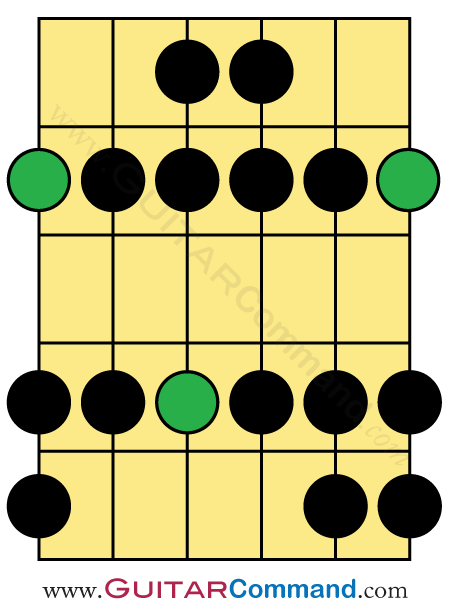


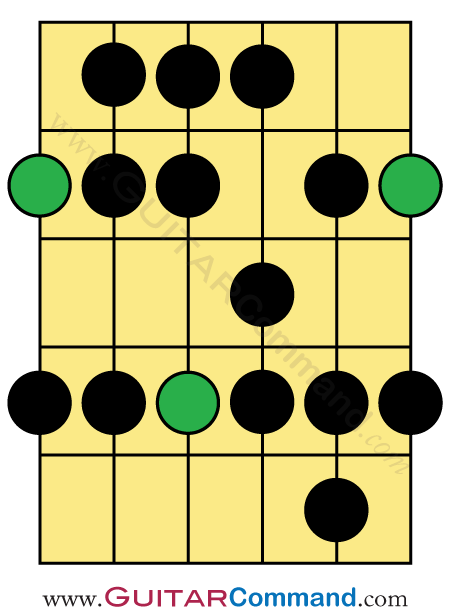




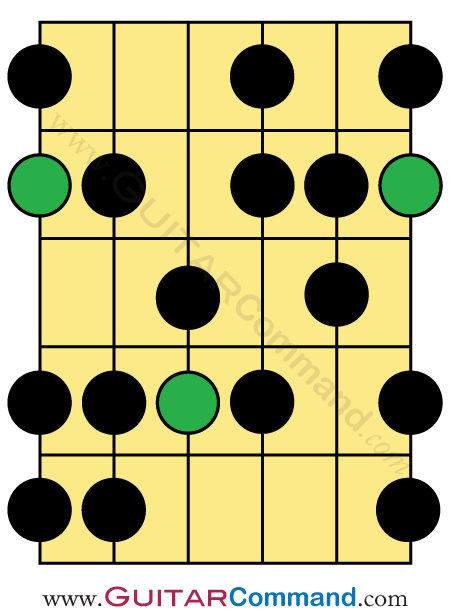


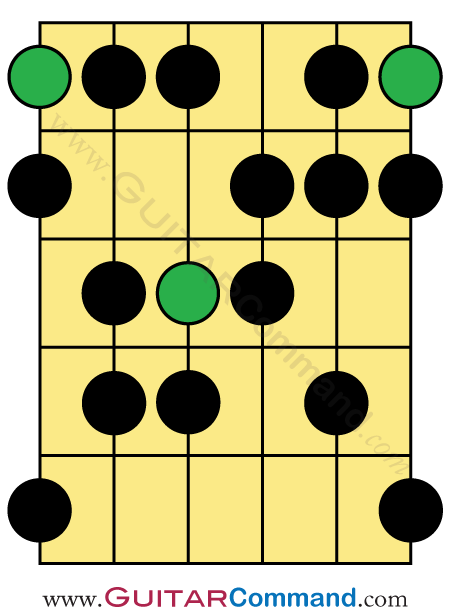





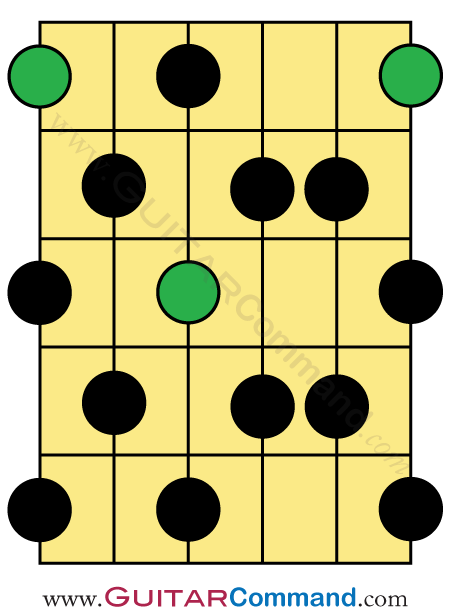


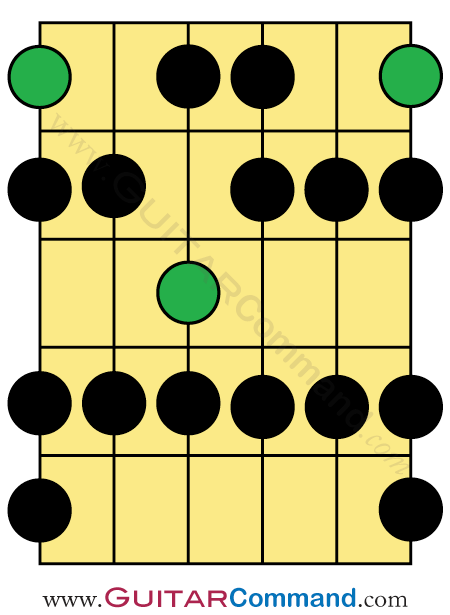






Awesome, thanks so much for this. Bookmarked.
Finally, Scales explained to me in a manor that I can understand. Awesome site, I will finally learn scales.
Thanks Wil, and good luck with your playing!
Thank you very much,this website have been very useful for me
I ordered “Lonely Blues” E min backing track on Amazon from G.C. U have to have it!!
Thanks Rozz, that’s awesome!
Excellent. Great help and well presented.
Thank you
excellent service
wow, wat a reservoir of scales all in 1 place.tnx man.i aprec8t.
Thanks, good to have all the scales in one place. I keep coming back!
Very good site.
Very good resource. Thankyou!
been using blues scales for 30 years. can’t teach and old dog new tricks!
Lol! Nothing wrong with that! 🙂
wow, such a lot of information. thank you!
Wow! Awesome page. Thank you from a guitar newcomer!